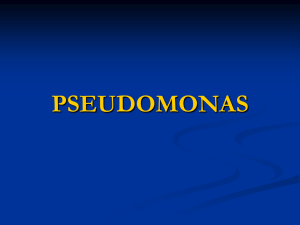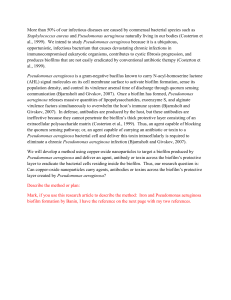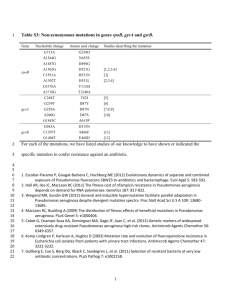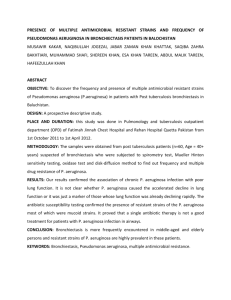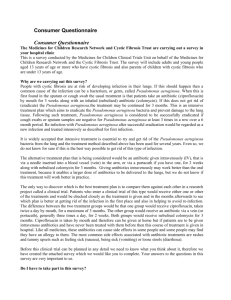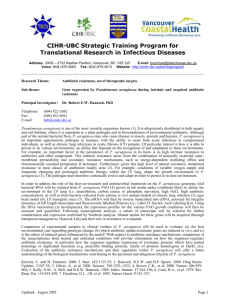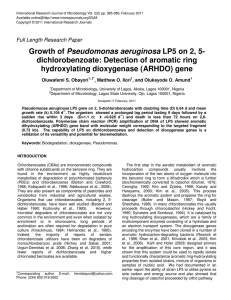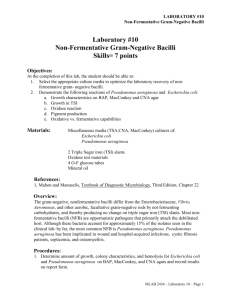Introduction
advertisement
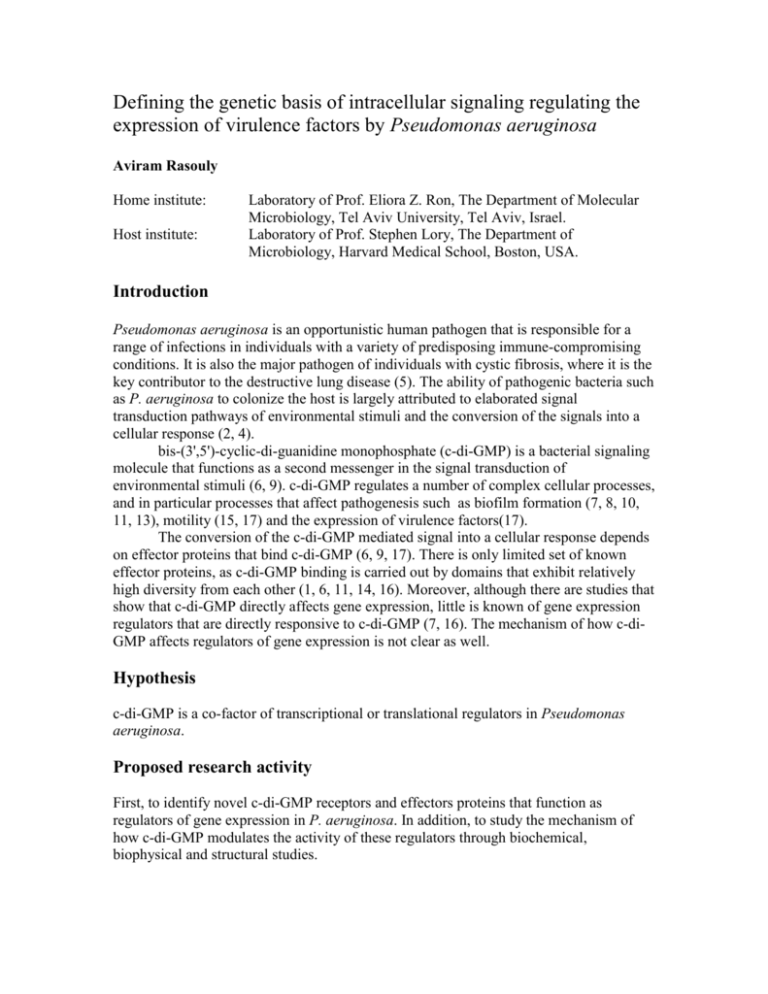
Defining the genetic basis of intracellular signaling regulating the expression of virulence factors by Pseudomonas aeruginosa Aviram Rasouly Home institute: Host institute: Laboratory of Prof. Eliora Z. Ron, The Department of Molecular Microbiology, Tel Aviv University, Tel Aviv, Israel. Laboratory of Prof. Stephen Lory, The Department of Microbiology, Harvard Medical School, Boston, USA. Introduction Pseudomonas aeruginosa is an opportunistic human pathogen that is responsible for a range of infections in individuals with a variety of predisposing immune-compromising conditions. It is also the major pathogen of individuals with cystic fibrosis, where it is the key contributor to the destructive lung disease (5). The ability of pathogenic bacteria such as P. aeruginosa to colonize the host is largely attributed to elaborated signal transduction pathways of environmental stimuli and the conversion of the signals into a cellular response (2, 4). bis-(3',5')-cyclic-di-guanidine monophosphate (c-di-GMP) is a bacterial signaling molecule that functions as a second messenger in the signal transduction of environmental stimuli (6, 9). c-di-GMP regulates a number of complex cellular processes, and in particular processes that affect pathogenesis such as biofilm formation (7, 8, 10, 11, 13), motility (15, 17) and the expression of virulence factors(17). The conversion of the c-di-GMP mediated signal into a cellular response depends on effector proteins that bind c-di-GMP (6, 9, 17). There is only limited set of known effector proteins, as c-di-GMP binding is carried out by domains that exhibit relatively high diversity from each other (1, 6, 11, 14, 16). Moreover, although there are studies that show that c-di-GMP directly affects gene expression, little is known of gene expression regulators that are directly responsive to c-di-GMP (7, 16). The mechanism of how c-diGMP affects regulators of gene expression is not clear as well. Hypothesis c-di-GMP is a co-factor of transcriptional or translational regulators in Pseudomonas aeruginosa. Proposed research activity First, to identify novel c-di-GMP receptors and effectors proteins that function as regulators of gene expression in P. aeruginosa. In addition, to study the mechanism of how c-di-GMP modulates the activity of these regulators through biochemical, biophysical and structural studies. References 1. 2. 3. 4. 5. 6. 7. 8. 9. 10. 11. 12. 13. 14. Amikam, D., and M. Y. Galperin. 2006. PilZ domain is part of the bacterial cdi-GMP binding protein. Bioinformatics 22:3-6. Brencic, A., and S. Lory. 2009. Determination of the regulon and identification of novel mRNA targets of Pseudomonas aeruginosa RsmA. Mol Microbiol 72:612-32. Deana, A., and J. G. Belasco. 2005. Lost in translation: the influence of ribosomes on bacterial mRNA decay. Genes Dev 19:2526-33. Goodman, A. L., M. Merighi, M. Hyodo, I. Ventre, A. Filloux, and S. Lory. 2009. Direct interaction between sensor kinase proteins mediates acute and chronic disease phenotypes in a bacterial pathogen. Genes Dev 23:249-59. Govan, J. R., and V. Deretic. 1996. Microbial pathogenesis in cystic fibrosis: mucoid Pseudomonas aeruginosa and Burkholderia cepacia. Microbiol Rev 60:539-74. Hengge, R. 2009. Principles of c-di-GMP signalling in bacteria. Nat Rev Microbiol 7:263-73. Hickman, J. W., and C. S. Harwood. 2008. Identification of FleQ from Pseudomonas aeruginosa as a c-di-GMP-responsive transcription factor. Mol Microbiol 69:376-89. Hickman, J. W., D. F. Tifrea, and C. S. Harwood. 2005. A chemosensory system that regulates biofilm formation through modulation of cyclic diguanylate levels. Proc Natl Acad Sci U S A 102:14422-7. Jenal, U., and J. Malone. 2006. Mechanisms of cyclic-di-GMP signaling in bacteria. Annu Rev Genet 40:385-407. Kulasakara, H., V. Lee, A. Brencic, N. Liberati, J. Urbach, S. Miyata, D. G. Lee, A. N. Neely, M. Hyodo, Y. Hayakawa, F. M. Ausubel, and S. Lory. 2006. Analysis of Pseudomonas aeruginosa diguanylate cyclases and phosphodiesterases reveals a role for bis-(3'-5')-cyclic-GMP in virulence. Proc Natl Acad Sci U S A 103:2839-44. Lee, V. T., J. M. Matewish, J. L. Kessler, M. Hyodo, Y. Hayakawa, and S. Lory. 2007. A cyclic-di-GMP receptor required for bacterial exopolysaccharide production. Mol Microbiol 65:1474-84. Livny, J., A. Brencic, S. Lory, and M. K. Waldor. 2006. Identification of 17 Pseudomonas aeruginosa sRNAs and prediction of sRNA-encoding genes in 10 diverse pathogens using the bioinformatic tool sRNAPredict2. Nucleic Acids Res 34:3484-93. Merighi, M., V. T. Lee, M. Hyodo, Y. Hayakawa, and S. Lory. 2007. The second messenger bis-(3'-5')-cyclic-GMP and its PilZ domain-containing receptor Alg44 are required for alginate biosynthesis in Pseudomonas aeruginosa. Mol Microbiol 65:876-95. Newell, P. D., R. D. Monds, and G. A. O'Toole. 2009. LapD is a bis-(3',5')cyclic dimeric GMP-binding protein that regulates surface attachment by Pseudomonas fluorescens Pf0-1. Proc Natl Acad Sci U S A 106:3461-6. 15. 16. 17. Simm, R., M. Morr, A. Kader, M. Nimtz, and U. Romling. 2004. GGDEF and EAL domains inversely regulate cyclic di-GMP levels and transition from sessility to motility. Mol Microbiol 53:1123-34. Sudarsan, N., E. R. Lee, Z. Weinberg, R. H. Moy, J. N. Kim, K. H. Link, and R. R. Breaker. 2008. Riboswitches in eubacteria sense the second messenger cyclic di-GMP. Science 321:411-3. Tamayo, R., J. T. Pratt, and A. Camilli. 2007. Roles of cyclic diguanylate in the regulation of bacterial pathogenesis. Annu Rev Microbiol 61:131-48.


